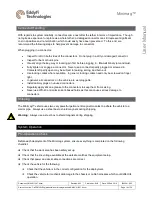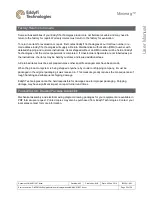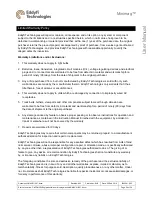
Minimag™
Document: UMAU011367.docm
Revision: A03
Created by: KJB
Date: 26 Sep 2019
3063241-A03
Source Location: C:\ePDM\ISLEng\products\au-micromag\manuals\UMAU011367.docm
Page 17 of 26
User Ma
nual
!
Fall Arrest
Due to the weight of the Minimag
™ vehicle, the Minitracs™ will back drive and not hold the position of the
vehicle during power loss or power shutdown. A lifeline or fall arrest system should be used at all time
when the vehicle is navigating on a vertical or inverted horizontal position.
A Kellems grip (wire mesh grip) on the tether has been provided to attach a fall arrest system. Another
optional fall arrest attachment point is the top handle of the SP90/light mount.
Warning:
Fall arrest system should be used during vertical or inverted horizontal operation.
Tether Handling
The tether should be considered the most important part of the vehicle system.
It feeds power and
control signals to the vehicle and returns data from the sensors. If the tether becomes damaged from
improper use, poor handling or an accident, the vehicle may become crippled or inoperable. This is a
serious situation because of the cost for tether repairs, as well as significant downtime and loss of
production. For maximum tether life and reliability, we offer the following tether handling tips:
Never step on the tether. Trampling the tether may crush conductors, leading to premature failure.
Trampling is also abrasive to the tether jacket. Trampling fosters the wrong attitude toward the tether.
Remember, this is an expensive multi-conductor tether, not a common electrical extension cord.
Never allow vehicles, trucks, cars, etc. to drive over the tether. This will do concentrated, immediate and
permanent damage. Set up cones or blockades to keep vehicles away.
Do not bend the tether beyond its minimum bend diameter. If the tether has difficulty bending, you have
bent it too far. If the tether is bent beyond its minimum diameter on pulleys or around corners, wire
fatigue will be accelerated. It is important that any pulleys or tackle support the tether at or beyond its
minimum bend diameter. For an extended fatigue life, the minimum bend diameter should be considered
larger.
Note:
For the standard Minimag system, the minimum tether bend diameter is 250mm (10in).
Never kink the tether. A kink will permanently bend a cable and may break a wire or fibre internally. Take
precautions to never allow the tether to kink. Kink situations may occur when there is slack tether with
closing loops, or when coils slip off a full drum.
Do not snap load the tether. Your tether has a maximum safe working load of 200kgf (450lbf) of tension.
Loads may peak at a very high value when the tether snaps taut. Snap loading may easily occur when a
slack tether is reeled onto a motorized spool, or when the vehicle is suspended from a swinging
deployment crane.
Avoid loading the tether unnecessarily. Unnecessary large loads will only shorten the fatigue life of the
tether.
Never fully un-spool the tether. The surface end of the tether is anchored to the spool drum. If the spool
is turned past the anchor point, the tether may be kinked or broken and require re-termination. To help
prevent this, a band of tape is typically wrapped around the last few coils to act as a visible and audible
warning that the tether is fully paid out.










































